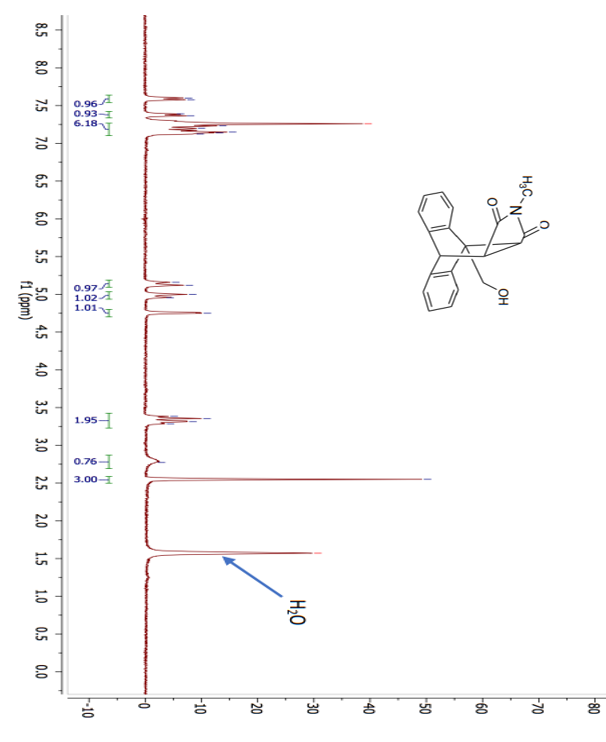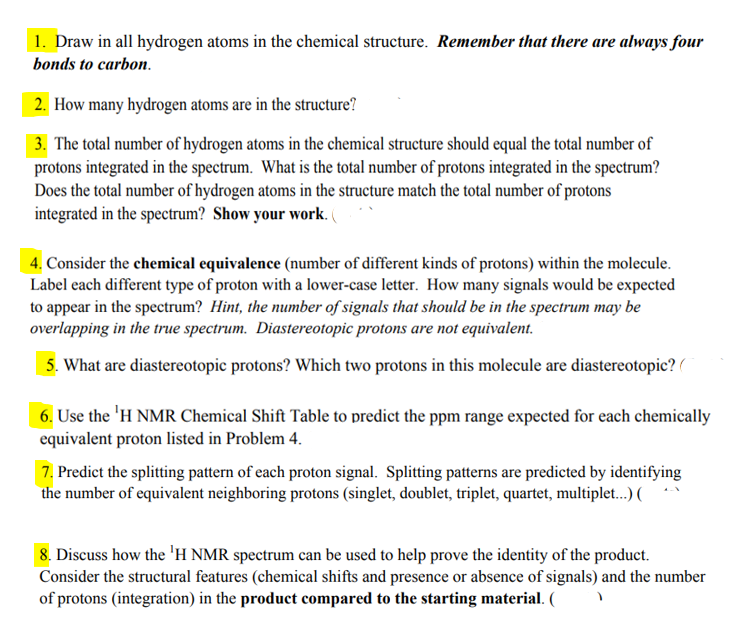1. Draw in all hydrogen atoms in the chemical structure. Remember that there are always four bonds to carbon. 2. How many hydrogen atoms are in the structure? 3. The total number of hydrogen atoms in the chemical structure should equal the total number of protons integrated in the spectrum. What is the total number of protons integrated in the spectrum? Does the total number of hydrogen atoms in the structure match the total number of protons integrated in the spectrum? Show your work.
1. Draw in all hydrogen atoms in the chemical structure. Remember that there are always four bonds to carbon. 2. How many hydrogen atoms are in the structure? 3. The total number of hydrogen atoms in the chemical structure should equal the total number of protons integrated in the spectrum. What is the total number of protons integrated in the spectrum? Does the total number of hydrogen atoms in the structure match the total number of protons integrated in the spectrum? Show your work.
Chemistry
10th Edition
ISBN:9781305957404
Author:Steven S. Zumdahl, Susan A. Zumdahl, Donald J. DeCoste
Publisher:Steven S. Zumdahl, Susan A. Zumdahl, Donald J. DeCoste
Chapter1: Chemical Foundations
Section: Chapter Questions
Problem 1RQ: Define and explain the differences between the following terms. a. law and theory b. theory and...
Related questions
Question
100%
could you help me with these question and explain to me step by step
thanks

Transcribed Image Text:8.5 8.0
0.96
0.93
6.18-
H3C
FO
7.5 7.0 6.5
R
OH
6.0
0.97
1.02 जू
1.01-
5.5 5.0 4.5 4.0
f1 (ppm)
Fsor
3.5
0.76-
3.00-
3.0 2.5 2.0
H2O
1.5 1.0
0.5 0.0
-80
-70
-60
-50
-40
-30
-20
-10
-0
-10

Transcribed Image Text:1. Draw in all hydrogen atoms in the chemical structure. Remember that there are always four
bonds to carbon.
2. How many hydrogen atoms are in the structure?
3. The total number of hydrogen atoms in the chemical structure should equal the total number of
protons integrated in the spectrum. What is the total number of protons integrated in the spectrum?
Does the total number of hydrogen atoms in the structure match the total number of protons
integrated in the spectrum? Show your work.
4. Consider the chemical equivalence (number of different kinds of protons) within the molecule.
Label each different type of proton with a lower-case letter. How many signals would be expected
to appear in the spectrum? Hint, the number of signals that should be in the spectrum may be
overlapping in the true spectrum. Diastereotopic protons are not equivalent.
5. What are diastereotopic protons? Which two protons in this molecule are diastereotopic? (
6. Use the 'H NMR Chemical Shift Table to predict the ppm range expected for each chemically
equivalent proton listed in Problem 4.
7. Predict the splitting pattern of each proton signal. Splitting patterns are predicted by identifying
the number of equivalent neighboring protons (singlet, doublet, triplet, quartet, multiplet...) (
8. Discuss how the 'H NMR spectrum can be used to help prove the identity of the product.
Consider the structural features (chemical shifts and presence or absence of signals) and the number
of protons (integration) in the product compared to the starting material. (
Expert Solution
This question has been solved!
Explore an expertly crafted, step-by-step solution for a thorough understanding of key concepts.
This is a popular solution!
Trending now
This is a popular solution!
Step by step
Solved in 3 steps with 1 images

Knowledge Booster
Learn more about
Need a deep-dive on the concept behind this application? Look no further. Learn more about this topic, chemistry and related others by exploring similar questions and additional content below.Recommended textbooks for you

Chemistry
Chemistry
ISBN:
9781305957404
Author:
Steven S. Zumdahl, Susan A. Zumdahl, Donald J. DeCoste
Publisher:
Cengage Learning

Chemistry
Chemistry
ISBN:
9781259911156
Author:
Raymond Chang Dr., Jason Overby Professor
Publisher:
McGraw-Hill Education

Principles of Instrumental Analysis
Chemistry
ISBN:
9781305577213
Author:
Douglas A. Skoog, F. James Holler, Stanley R. Crouch
Publisher:
Cengage Learning

Chemistry
Chemistry
ISBN:
9781305957404
Author:
Steven S. Zumdahl, Susan A. Zumdahl, Donald J. DeCoste
Publisher:
Cengage Learning

Chemistry
Chemistry
ISBN:
9781259911156
Author:
Raymond Chang Dr., Jason Overby Professor
Publisher:
McGraw-Hill Education

Principles of Instrumental Analysis
Chemistry
ISBN:
9781305577213
Author:
Douglas A. Skoog, F. James Holler, Stanley R. Crouch
Publisher:
Cengage Learning

Organic Chemistry
Chemistry
ISBN:
9780078021558
Author:
Janice Gorzynski Smith Dr.
Publisher:
McGraw-Hill Education

Chemistry: Principles and Reactions
Chemistry
ISBN:
9781305079373
Author:
William L. Masterton, Cecile N. Hurley
Publisher:
Cengage Learning

Elementary Principles of Chemical Processes, Bind…
Chemistry
ISBN:
9781118431221
Author:
Richard M. Felder, Ronald W. Rousseau, Lisa G. Bullard
Publisher:
WILEY